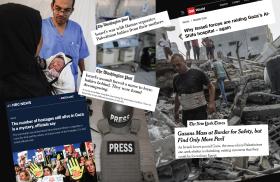
- Policy Analysis
- Articles & Op-Eds
Here’s the Real Problem with the U.N.’s Revised Gaza Death Toll
Also published in Washington Post

The adjusted numbers reflect the many challenges of counting deaths in a chaotic urban conflict.
The United Nations recently roiled discussions of the Gaza death toll when the organization altered the way it cites reporting on those killed in Israel’s counterattack against Hamas. The number of women and children killed, in the tally offered by the United Nations, suddenly dropped by nearly half, even as the overall death toll was almost unchanged. Yet the revision was neither a stunning rollback, as some claimed, nor an inconsequential shift, as others insisted.
Rather, the adjusted numbers reflect a combination of U.N. missteps in evaluating conflicting information reported by Hamas-run authorities, nontransparent casualty-counting techniques and the difficulty of counting deaths in a chaotic urban conflict.
Controversy over the Gaza death toll frequently devolves into a partisan, callous fight that obscures real problems with the death toll reporting—problems that significantly influence public perceptions and policymaking decisions. Assessing claims about the death toll, whether those alleging a massive overcount or undercount, requires a close examination of the timeline involved, methodologies at play and available data.
When the war began after Hamas’s Oct. 7 mass atrocities, Hamas’s Gaza Health Ministry initially counted deaths through its hospital and morgue system, in which bodies are identified and information is entered into a central database. This system’s accuracy in previous conflicts is sometimes regarded as evidence of its reliability in the present war. But in the past, the Health Ministry’s count could be independently checked by the U.N.’s Office for the Coordination of Humanitarian Affairs, working with other U.N. agencies and nongovernmental organizations. That critical real-time verification, which also distinguished between civilian and combatant casualties, is absent now.
An additional complication: The Health Ministry is using three separate methodologies of varying reliability. By early November, when the Israel Defense Forces’ ground operation necessitated the closing and evacuation of hospitals in northern Gaza, the Health Ministry began using a new and opaque methodology in that area: “reliable media sources.”
This methodology, which has never been explained, quickly became the dominant input into the death toll, peaking at 45 percent of total cumulative reported deaths in late March. In January, the Health Ministry added a third methodology: self-reports, via a Google Form, from family members of those killed. The Health Ministry released the first tranche of that data in late March. As of May 3, hospitals and morgues accounted for roughly 60 percent of fatalities reported; media sources, 29 percent; and family member self-reports, 11 percent. The Health Ministry provided demographic data for hospital-morgue reports and self-reports in 41 Telegram releases published Dec. 11-May 3, along with four lists providing names of the dead, the most recent released May 5.
Demographic analysis of the 24,682 names listed with a given age indicates that 45.6 percent of those killed were men, 23.1 percent were women and 31.3 percent were children. Since almost half of Gazans are children, and just over one-quarter each are men and women, this shows significant underrepresentation of children and overrepresentation of men, particularly those ages 20 to 45. (The latter is not surprising; these Gazans are the most likely to be combatants.) Among the self-reports from families, which seem more likely to reflect the deaths of combatants, men account for more than 55 percent.
For months after the war began, the Health Ministry reported that 70 percent of those killed in Gaza were women and children, but its own data has not supported the claim since mid-December. The U.N.’s Office for the Coordination of Humanitarian Affairs stopped reporting the 70 percent figure in January, and the Health Ministry itself quietly dropped the claim in late March.
For months, Hamas’s government media office has provided fatality figures with reported overall totals for women and children killed that cannot be reconciled with the Health Ministry’s data from the hospital-morgue and self-reports. The gap is big enough that for the media office and Health Ministry numbers to line up, the number of men reported killed via the media reports methodology would have to be either minuscule or negative.
Despite this, and an admission in December that the Hamas government media office’s “methodology is unknown,” the United Nations cited its figures for months, forgoing higher-quality Health Ministry information. This led to widespread confusion—and extensive media coverage—on May 8, when the United Nations reverted to reporting Health Ministry data and differentiated between “identified” (hospital-morgue and self-reports) and “unidentified” fatalities.
Yet this new framing obscures reality. The “identified” data has become increasingly incomplete over time, and 17.1 percent of the “identified” entries in the Health Ministry’s early-May release have missing or invalid IDs, ages, names or sex. Meanwhile, the “unidentified” entries are actually a rebranding of the data from the media reports methodology, a change made in April as outside scrutiny grew.
It is unusual for the United Nations, which normally uses a strict casualty verification standard, to report unverified casualty figures from involved parties. The United Nations stopped reporting the death toll in Syria between 2014 and 2021 amid verification difficulties, and it has not even attempted comprehensive casualty reporting in the Ethiopian civil war. In Sudan, the verified U.N. death toll is nearly exceeded by estimated fatalities from a single city.
A better approach for the U.N.’s Office for the Coordination of Humanitarian Affairs would be to stop citing statistics from Hamas’s government media office, which lacks the capacity or authority to count casualties, and to distinguish between the three Health Ministry methodologies, while applying basic scrutiny to claims by all parties.
What can a partial and contested picture of the death toll, patched together through three methodologies of varying reliability, tell us? It cannot yield a civilian-combatant ratio, given the Health Ministry’s refusal to distinguish between the two and the likely undercounting of militants killed on the battlefield. It also cannot help assess the legality of individual Israeli strikes or operations. Nor is the claimed death toll a clear undercount: 40 percent of reported deaths derive from methodologies that do not involve physical identification of a body, creating likely overlap with those reported missing or under the rubble. The approach also cannot convey the enormous loss of life experienced by Gazans. The data can give only broad indications: namely, that fighting-age men are overrepresented among the dead and that there has been a steady decline in the daily death toll, from an average of 341 in October to 56 in April.
A core criticism of Israeli conduct is that it has inflicted a high civilian death toll—the numbers have featured prominently in the news media, in remarks by international leaders, in arguments before the International Court of Justice and in criticism from the U.S. government. Yet the methodologies employed by the Hamas-run organizations compiling the information have been subjected to remarkably little scrutiny.
Exercising caution is essential when dealing with claims made about death tolls in any conflict, particularly claims made by warring parties. That means being transparent in acknowledging flaws in the available data and methodologies; failure to do so inevitably leads to suspicion that the data is being employed with a political goal in mind. The United Nations, government officials, media outlets and policy analysts have an obligation to employ the same professionalism and diligence regarding the war in Gaza that they have applied in other conflicts.
Gabriel Epstein is a research assistant in The Washington Institute’s Koret Project on Arab-Israel Relations. This article was originally published on the Washington Post website.


